Understanding Threats to Black Bee Populations
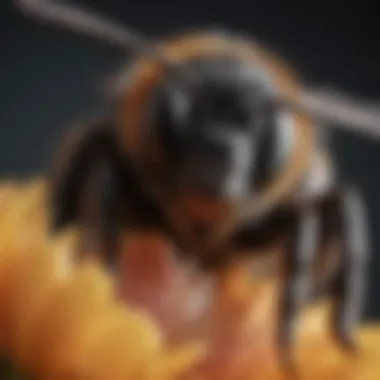
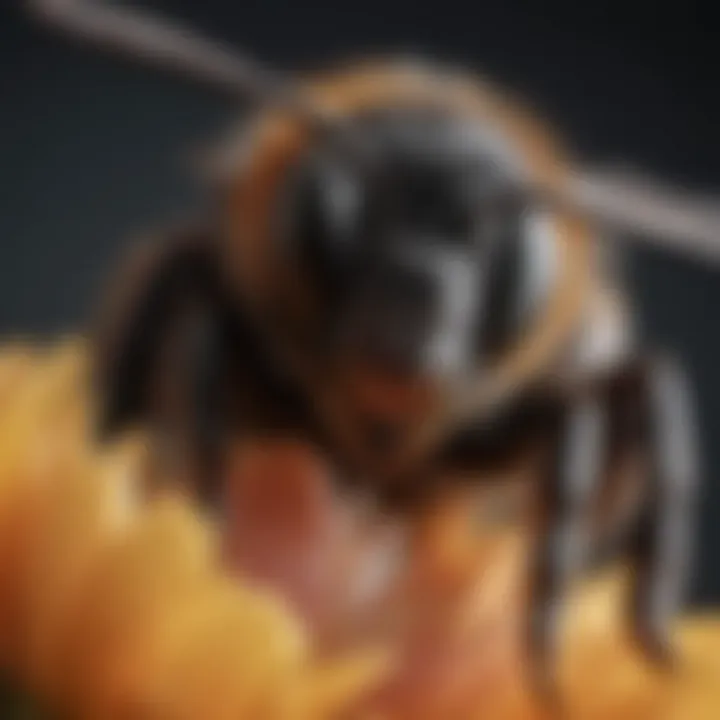
Intro
The decline of black bee populations is an alarming trend that demands attention. These bees play a vital role in pollination, supporting ecosystem health and agricultural productivity. Understanding the various threats that contribute to their mortality is essential for conservation efforts. This article will explore the environmental, biological, and anthropogenic factors affecting black bees, as well as the implications of their decline on biodiversity.
Environmental Threats
Environmental factors have a significant impact on black bee health. Climate change presents a direct challenge, altering habitats and availability of food sources. Extreme weather events, such as droughts and floods, can disrupt their foraging patterns. Rapid changes in temperature and precipitation patterns might decimate their populations.
Habitat Loss
Habitat fragmentation is another pressing issue. Urban development, agricultural expansion, and deforestation diminish the natural environments these bees rely on. When their habitats shrink, black bees face challenges in finding sufficient food and nesting sites.
"Preserving natural habitats is crucial for the survival of black bees and other pollinators."
Biological Threats
Biological threats also contribute to decline in black bee populations. Pests and diseases pose significant risks.
Parasites
Varroa destructor, a mite that feeds on bee blood, is notorious for weakening bee colonies. Its presence can lead to colony collapse if not managed. Additionally, various pathogens can spread through colonies, increasing mortality rates.
Competition
Moreover, competition from non-native bee species can strain resources. When non-native species arrive, they may outcompete black bees for food and nesting sites, further reducing their populations.
Anthropogenic Threats
Human activities play a pivotal role in jeopardizing black bee populations. Pesticide use in agriculture has been linked to bee mortality.
Pesticides
Neonicotinoids, a class of insecticides, can impair foraging behavior and reproduction. Reducing pesticide exposure in agricultural practices can positively impact black bee health, though transitions to safer methods require time and effort.
Climate Change
Human-induced climate change also exacerbates the threats black bees face. Rising temperatures and altered landscapes can create inhospitable environments.
Conservation Strategies
Taking steps to protect black bee populations is vital for ensuring their survival. Implementing sustainable farming practices can minimize pesticide exposure and restore habitats.
Community Involvement
Encouraging community participation in local conservation efforts can help create safe havens for black bees. Initiatives such as planting pollinator-friendly gardens and preserving wild areas can foster environments conducive to their survival.
Research and Monitoring
Ongoing research is necessary to monitor black bee populations and assess the effectiveness of conservation strategies. Collaborations between scientists, policymakers, and the public can ensure comprehensive action.
Closure
The decline of black bee populations is a multi-faceted issue that requires immediate attention. By understanding the threats and implementing targeted conservation strategies, it is possible to safeguard the future of these essential pollinators. The interplay of environmental, biological, and anthropogenic factors calls for a robust response to protect black bees and maintain biodiversity.
Prelude to Black Bees
Black bees, often seen in various ecosystems, play a significant role in maintaining biodiversity and supporting agricultural productivity. Understanding the complexities of black bee populations is critical, particularly as their numbers are declining. This section serves as a foundational insight into these essential pollinators, addressing their classification and ecological significance.
Defining Black Bees
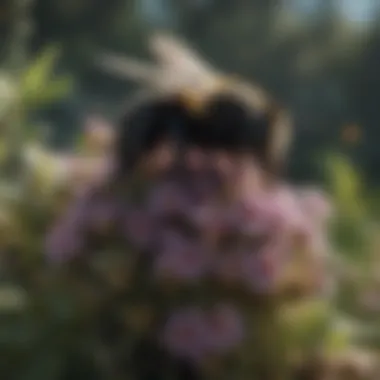
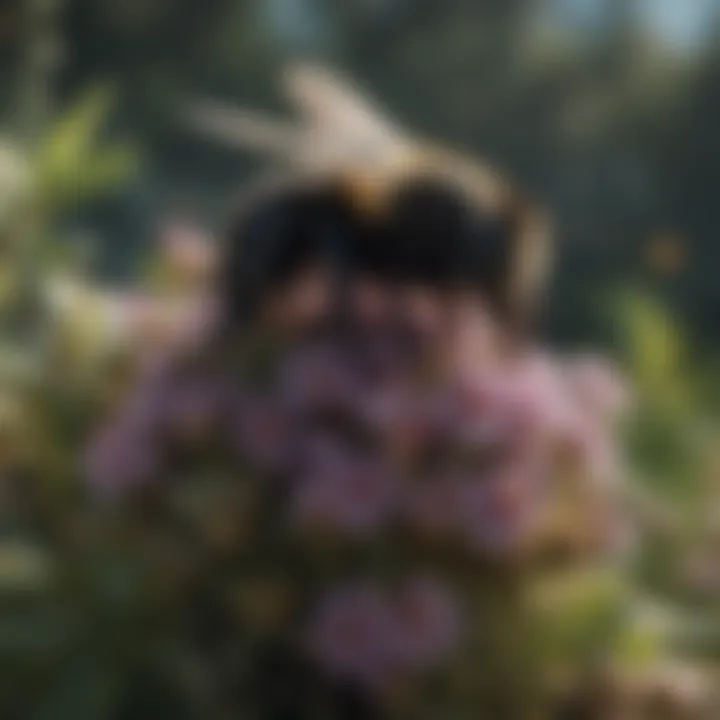
Black bees refer to a group of bee species that are characterized by a dark coloration, often with relatively hairless bodies. They include, among others, the European black bee, Apis mellifera mellifera, and native species like the black bumblebee, Bombus ruderatus. These bees exhibit unique physical traits, such as robust bodies and distinctive flying patterns. Additionally, black bees are vital to the health of ecosystems where they reside, pollinating a variety of plants, including many that are crucial for food production.
A comprehensive understanding of black bees necessitates their differentiation from other bee species. For example, they can be contrasted with honey bees, which are often yellow and have more pronounced hair on their bodies. Identifying and categorizing black bees helps in recognizing their specific needs and the threats they face in different environments.
Ecological Importance
Black bees hold a crucial role in the ecological fabric. They are among the primary pollinators, ensuring the reproduction of numerous plant species. The process of pollination is essential for the growth of fruits, vegetables, and flowers, which not only provide food sources but also maintain the habitats for countless organisms.
"Pollinators like black bees contribute to biodiversity and support food systems on which we all depend."
Their activities facilitate the production of seeds and fruits, thus sustaining not just plant life but also the animals and humans that rely on these plants for sustenance. Furthermore, the loss of black bees can lead to a decline in plant variety, which can trigger a cascade of negative effects throughout food webs.
Understanding the ecological importance of black bees is paramount as it highlights the need for conservation measures. It is essential for landowners, gardeners, and communities to recognize their contributions to the environment. By promoting awareness about black bees and their role in pollination, individuals can foster protective efforts that counteract the many threats these vital organisms face.
Natural Predators and Their Impact
Understanding the role of natural predators is essential when studying the decline of black bee populations. Predation can significantly influence the survival and reproduction rates of black bees, contributing to the overall dynamics of their populations. This section explores the various natural predators that pose threats to black bees and examines the implications of these predatory relationships.
Predation by Other Insects
Insect predation is a notable concern for black bees. Various species, including wasps and flies, target black bees and their larvae. These predators often have specialized behaviors that allow them to effectively hunt and capture their prey. For example, wasps are known for their aggressive hunting strategies and ability to invade hives, where they can kill adult bees and consume larvae. The pressure exerted by these predatory insects can lead to significant reductions in bee populations.
Black bees, while a crucial species for pollination, do not possess substantial defenses against such predation. The stress from constant predation can lead to weakened colonies, making them more susceptible to disease and environmental changes. Predators can also alter foraging patterns, forcing black bees to expend more energy and time on survival rather than reproduction.
Birds and Mammalian Predators
Birds and mammals add another layer of threat to black bee populations. Species such as woodpeckers or blue jays are known to feed on bees, targeting them during foraging flights. These avian predators often hunt bees not only for food but also for the protein-rich larvae found within hives.
Mammals, like raccoons, have been observed raiding bee nests, accessing colonies for honey and larvae. This behavior results in direct losses of not just individual bees, but entire colonies. The survival of black bee populations becomes compromised due to the dual threat from both insect and vertebrate predators.
The impact of these predators is amplified by the fact that black bees often do not thrive in highly fragmented habitats. As landscapes change due to urbanization and agriculture, the availability of resources becomes limited and makes bees more vulnerable to predation.
"Predation pressure can lead to declining numbers and ultimately affect pollination services in ecosystems."
Pathogens and Parasites
Pathogens and parasites represent significant threats to black bee populations. They can disrupt bee health and influence overall colony success. Understanding these factors is essential for conservation efforts. With the increasing decline in black bee populations, evaluating the impact of these organisms is not only relevant, it is critical.
Role of Varroa Mites
Varroa mites, scientifically known as Varroa destructor, are perhaps the most well-known parasite affecting honeybee colonies, including black bees. These small arachnids attach to bees and feed on their bodily fluids. The direct effect of mite infestation is the weakening of individual bees, which can lead to physical deformities and reduced longevity.
In addition, Varroa mites can also transmit various viruses, contributing to a second layer of impact on bee populations. Their reproductive cycle synchronizes with that of bees, allowing them to reproduce in the brood cells, which further amplifies their population and impact. It is common for infested colonies to experience significant declines in population as the stress on the hive increases due to both parasitic feeding and virus exposure.
Maintaining hives using management practices to control Varroa populations is vital for sustaining healthy black bee populations. Some methods include regular monitoring and the use of miticides, while integrated pest management practices can help mitigate risks without harmful side effects.
Fungal Infections and Bacterial Diseases
Fungal infections and bacterial diseases can severely impact black bee colonies. Common fungal pathogens include Ascosphaera apis, which causes chalkbrood, and Nosema apis, a microsporidian parasite. The former affects the larval stage of bees, resulting in the premature death of larvae, while the latter reduces the digestive efficiency of adult bees, weakening the entire colony.
Bacterial diseases such as American foulbrood caused by Paenibacillus larvae can devastate colonies. This bacterium attacks larvae in the brood cell, leading to their death and, ultimately, the collapse of the colony. Addressing these diseases requires vigilance in hive management and hygiene practices, as infected colonies can quickly spread pathogens to others. Timely detection and treatment are necessary for effective control.
Viruses Affecting Black Bees
Viruses compose another significant threat to black bee populations. Several viral strains can infect bees, and many of these are exacerbated by the presence of Varroa mites. Common viruses affecting black bees include the Deformed Wing Virus, which causes malformations, and the Black Queen Cell Virus, which affects queen bees.
The economic and ecological consequences of viral infections can be severe, leading to lower reproductive success and higher mortality rates in colonies. Moreover, as bee populations decline, their roles in pollination and ecosystem balance are jeopardized. Therefore, a focus on research and monitoring of viral load in black bees is essential to understand the full impact of these pathogens and develop effective management strategies.
Black bee populations face a multifaceted threat from pathogens and parasites, making their preservation an urgent priority in conservation efforts.
By understanding the impacts of these pathogens and parasites, stakeholders can make informed decisions regarding conservation strategies. Collaboration between researchers, beekeepers, and conservationists is crucial to implement effective measures and improve the resilience of black bee populations.
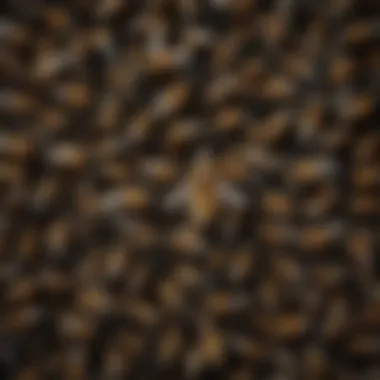
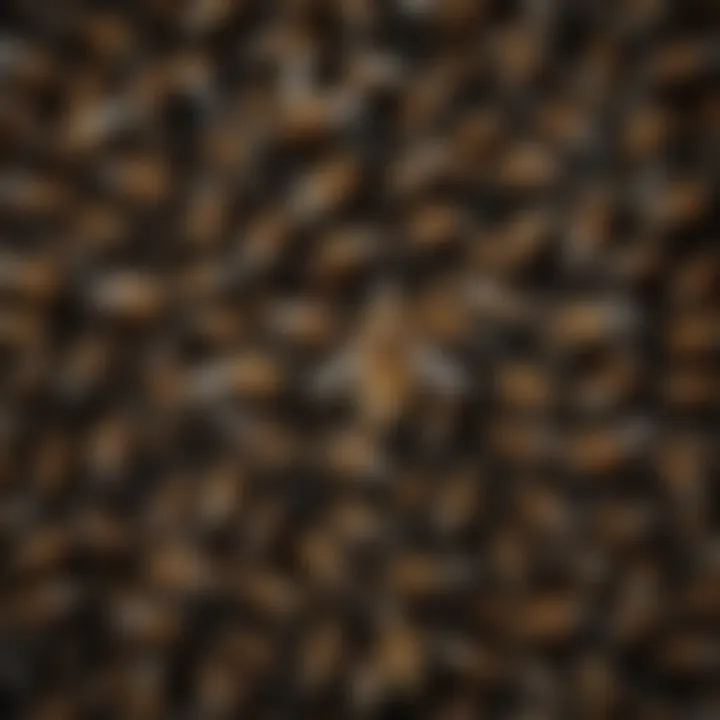
Environmental Changes
Environmental changes play a crucial role in understanding the threats to black bee populations. These changes refer to the varied physical and biological alterations in their habitats that directly affect their survival and reproduction. As environments evolve, black bees are exposed to new challenges that can influence their population dynamics significantly. Recognizing how climate variations, habitat alteration, and urban intrusion impact these bees is essential for implementing effective conservation strategies.
Climate Change Effects
Climate change represents a major threat to black bee populations. The rising temperatures and changing weather patterns affect their foraging behavior, breeding seasons, and overall habitat stability. Black bees are particularly sensitive to temperature fluctuations. Warmer winters may lead to earlier floral blooms, which can disrupt the synchronization between forager activity and food availability.
Moreover, extreme weather events like droughts and heavy rains can reduce the quality and quantity of blooming plants that black bees rely on. Their ability to adapt to these rapid changes is limited, and thus, they can struggle to find suitable habitats. Additionally, the increase in invasive plant species due to shifting climates can outcompete native flora, further diminishing the food resources available for black bees.
Habitat Loss and Fragmentation
Habitat loss and fragmentation are significant concerns for black bees. The conversion of natural landscapes into agricultural land, urban areas, or infrastructure has resulted in a marked decline in the available habitats. With fewer spaces to thrive and reproduce, black bees face heightened risks of local extinction. Fragmented habitats limit the range of foraging opportunities and create isolated populations that may struggle to maintain genetic diversity.
Urbanization also contributes to habitat loss for black bees. The spread of buildings and roads creates barriers that prevent bees from interacting with diverse habitats. Key nesting sites are lost when natural areas are developed, which can lead to decreased nesting success. Overall, as natural habitats disappear and become increasingly fragmented, black bees must confront an uncertain future, with dwindling resources and increased competition from other species.
"Habitat destruction from human activity disrupts the delicate balance needed by black bees to thrive."
Addressing environmental changes by improving habitat conservation is vital. Efforts should focus on maintaining diverse ecosystems that provide the conditions necessary for black bees to flourish. Such initiatives are crucial for preserving the biodiversity of an area while ensuring that black bees have the resources they need to survive in an ever-changing world.
Chemical Exposure
Chemical exposure represents a significant threat to black bee populations. Understanding the implications of various chemicals used in agriculture and urban settings is crucial for conservation efforts. The increasing use of pesticides and herbicides can lead to a direct decrease in bee populations. These substances can be toxic, causing acute or chronic effects, and their presence in the environment can disrupt bee behaviors, impacting feeding and reproduction.
Pesticides and Herbicides
Pesticides are widely used to manage pests in agriculture. Their effectiveness, however, comes at a cost. Black bees, like other pollinators, are vulnerable to these chemicals. Neonicotinoids are particularly concerning, as they affect the nervous systems of insects. Studies show that exposure to such pesticides can lead to disorientation, reduced ability to forage, and even death.
Herbicides, on the other hand, contribute to habitat loss by eliminating flowering plants that provide essential food sources for bees. A decline in native flora can lead to further stresses on bee populations, exacerbating the challenges they face.
The long-term persistence of these chemicals in the environment complicates the issue further. Bees might be exposed to low levels of pesticides over extended periods, leading to chronic health problems influenced by many factors. Integrating safer farming practices can reduce chemical usage and limit the exposure of black bees to these harmful substances.
Contaminants in the Environment
Beyond pesticides and herbicides, there are other environmental contaminants affecting black bees. Heavy metals and pollutants from industrial processes can accumulate in the soil and water, impacting the plants that bees rely on for nourishment. These contaminants can have sub-lethal effects on bee health, leading to weakened immune systems and increased susceptibility to diseases.
Another concern is the presence of microplastics found in various habitats. Recent studies suggest that these tiny particles can be ingested by bees, potentially leading to harmful health consequences. As urban areas expand, the risk of contamination increases, posing challenges for black bee survival.
"The cumulative impact of chemical exposure can have dire consequences for the health and stability of bee populations, requiring immediate attention from both researchers and policymakers."
For more insight regarding the effects of pesticides, consider exploring resources from Britannica and Wikipedia.
Impact of Agricultural Practices
Understanding the impact of agricultural practices on black bee populations is crucial. These practices influence the bees' habitats, food sources, and overall health. As agriculture expands, the environment in which black bees thrive undergoes significant changes. The effects can be profound, risking both individual bee health and the stability of their populations.
Intensive Farming Techniques
Intensive farming refers to agricultural methods that maximize productivity. This may involve using large quantities of fertilizers, pesticides, and herbicides. While these techniques can enhance crop yields, they often lead to detrimental effects on the environment and non-target species, including black bees.
- Pesticide Use: Pesticides are designed to eliminate pests. However, they can also harm beneficial insects like black bees. These chemicals can disrupt the bees' learning abilities, navigation skills, and reproductive health. Exposure can be acute or chronic, affecting bee populations over time.
- Reduced Foraging: The use of intensive farming techniques can lead to a decline in the availability of floral resources. As fields become uniform with single crops, bees have less access to diverse nectar sources. This lack of food can weaken colonies and lower their resilience.
- Soil Degradation: Intensive farming often results in soil degradation, reducing its fertility. Poor soil health affects plants' growth, which in turn impacts the food supply for bees. A balanced ecosystem is vital for the survival of pollinators.
Monoculture and Its Consequences
Monoculture is another agricultural practice characterized by growing a single crop over a wide area. This practice simplifies farming but creates a complex set of issues for black bees.
- Decrease in Biodiversity: By focusing on one crop, the variety of plants available for bees diminishes. Diverse plant life provides bees with a range of nutrients throughout the seasons. Monoculture limits this access, leading to nutritional deficiencies.
- Increased Vulnerability: When environments lack diversity, they become more susceptible to diseases and pests. A monoculture system can rapidly escalate the spread of pathogens, affecting not only crops but also the health of black bees in proximity.
- Altered Ecosystems: The reduction of varied plant life affects the entire ecosystem. Pollination patterns change, which can destabilize food webs. Black bees rely on a robust ecosystem to thrive; without it, their populations can dwindle.
"By understanding how farming alters the habitats of black bees, we can begin to implement solutions that benefit both agriculture and the environment."
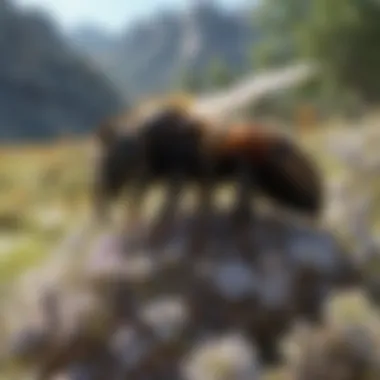
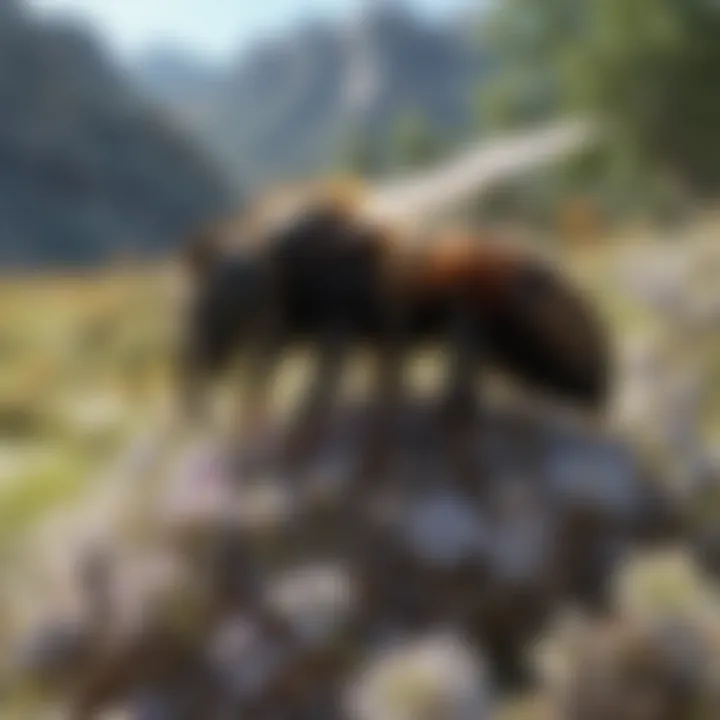
Addressing these agricultural impacts is essential for ensuring a future where black bees can thrive alongside productive farming.
Human Activities and Urbanization
Human activity is a major factor influencing the survival of black bee populations. Understanding these activities helps to uncover the threats they pose. Urbanization changes land use in ways that often do not favor local wildlife. This shift can disrupt habitats necessary for black bee prosperity.
Effects of Urban Development
Urban development brings concrete and buildings to previously green spaces. This transformation results in the loss of flowering plants that black bees rely on for food. As cities expand, green areas are often replaced by developments that do not support diverse flora.
- Habitat Loss: The removal of meadows and gardens directly impacts bee foraging areas. Few plants in urban settings offer suitable resources for bee species.
- Reduction of Nesting Sites: Black bees require specific nesting substrates. Urban environments typically lack natural nesting materials, pushing bees to relocate or risk extinction.
By minimizing their foraging and nesting opportunities, urban settings create significant barriers to the sustainability of black bee populations.
Light Pollution and Its Effects
Light pollution is an often-overlooked consequence of urbanization. Artificial lighting can disrupt the natural behaviors of black bees. For example, nocturnal activity may be triggered at inappropriate times due to bright city lights, altering their feeding patterns.
"Artificial light can confuse black bees, disrupting their natural foraging routines and ultimately affecting their well-being."
- Altered Flight Patterns: Black bees may not navigate effectively in artificially lit environments. This can lead to reduced foraging success and increased mortality.
- Disruption of Breeding Cycles: The presence of urban lights can also impact reproductive behaviors, as light influences the biological clocks of many creatures.
To mitigate these impacts, urban planning needs to consider the ecological needs of black bees. Incorporating green spaces and reducing light pollution can help create a more bee-friendly urban environment. This approach is vital for supporting the delicate balance of local ecosystems and preserving black bee populations.
Conservation Strategies
The conservation of black bee populations is not merely a noble effort; it is essential for maintaining ecological balance. The decline of these pollinators threatens both biodiversity and agricultural productivity. Thus, conservation strategies aim to mitigate the adverse effects of various threats faced by black bees. These strategies can foster healthier environments and support sustainable ecosystems.
Implementing effective conservation strategies entails a combination of habitat protection and rehabilitation, fostering biodiversity, and raising public awareness. Homeowners and gardeners play a critical role in these efforts. By actively contributing to conservation programs, communities can create environments that support the survival of these critical species.
Habitat Restoration Efforts
Restoring natural habitats is crucial for black bee populations. This involves efforts to revive degraded ecosystems, allowing them to regain their protective and nurturing capabilities. The process of restoration includes planting native flora, removing invasive species, and improving soil health. Native plants provide food sources and nesting sites for black bees. The restoration of wetlands, forests, and grasslands can significantly enhance the habitats black bees depend on.
In urban areas, even small patches of blooming flowers can make a difference. Community-driven projects like urban gardens or pollinator parks allow residents to participate in local conservation initiatives. Such efforts not only support black bees but also connect communities with nature.
"Creating spaces that mimic natural ecosystems can improve local biodiversity and aid in the survival of black bee populations."
Promoting Biodiversity in Gardens
Home gardens provide a unique opportunity to promote biodiversity, especially for black bees. Homeowners can transform their gardens into welcoming habitats for these essential pollinators. The introduction of diverse plant species increases the availability of nectar and pollen, which are pivotal for feeding black bees. Choosing native plants ensures that the ecosystem remains balanced and supports local wildlife.
Furthermore, reducing pesticide usage in gardens can drastically lower the risk of harm to black bee populations. This practice promotes a more organic approach to gardening and fosters a healthier ecosystem.
Several strategies can be employed in gardens to enhance biodiversity:
- Plant a Variety of Flowers: Select blooms that flower at different times throughout the seasons. This ensures a continuous food supply.
- Create Shelter: Leave some areas of the garden undisturbed. This provides natural nesting sites for black bees.
- Educate Others: Share knowledge about the significance of black bees and sustainable garden practices with neighbors and friends.
By fostering environments that support black bees, individuals contribute significantly to their conservation. These actions are not only beneficial for the species but also enhance the overall health of local ecosystems.
Finale and Future Perspectives
Understanding the myriad threats to black bee populations is essential for instigating effective conservation strategies. The black bee is a vital component of our ecosystems, contributing to pollination and biodiversity. If their populations continue to decline, it could lead to significant ecological imbalances. Therefore, recognizing the pressing nature of this issue is critical.
Efforts to manage and mitigate the threats faced by black bees involve a combination of ecological awareness and proactive measures. These can include habitat restoration, minimizing pesticide use, and increasing public awareness about the plight of these bees. By addressing these factors collectively, we can establish a healthy environment conducive to the survival and flourishing of black bee populations.
Summary of Key Points
- Black bees play a critical role in pollination, impacting a variety of plants and ecosystems.
- Factor such as predation, pathogens, environmental changes, chemicals, and agricultural practices significantly affect their populations.
- Conservation strategies must focus on habitat restoration and promoting biodiversity.
- The cumulative effects of human activities, like urbanization, further threaten their survival.
- Raising public awareness is necessary for fostering community support for conservation efforts.
Call to Action for Conservation
It is imperative for individuals, communities, and governments to engage in conservation actions targeting black bee populations. Here are some actions worth considering:
- Support Local Initiatives: Participate in local conservation initiatives that aim to restore bee habitats.
- Advocate for Organic Practices: Choose organic gardening methods to reduce chemical exposure to bees.
- Educate Others: Share knowledge about the importance of black bees and the threats they face.
- Create Friendly Environments: Incorporate native plants in gardens and landscapes, providing necessary habitats.
- Engage with Local Policymakers: Encourage policies that protect pollinators and promote biodiversity in urban areas.
Protecting black bee populations is not just an environmental concern; it is a commitment to sustaining the ecosystems upon which we all depend.















